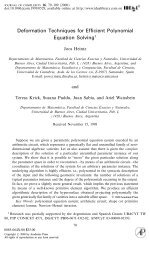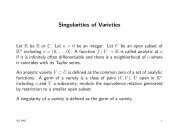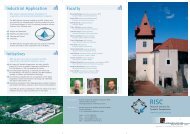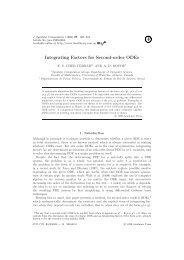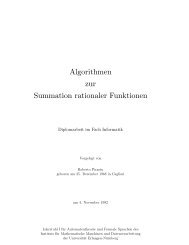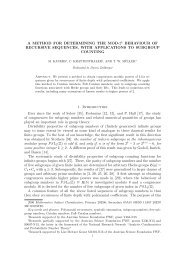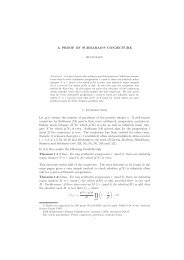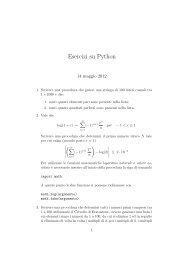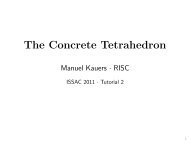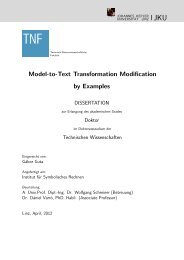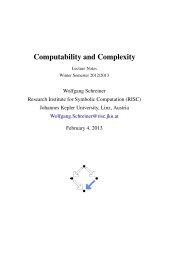Automated Formal Static Analysis and Retrieval of Source Code - JKU
Automated Formal Static Analysis and Retrieval of Source Code - JKU
Automated Formal Static Analysis and Retrieval of Source Code - JKU
You also want an ePaper? Increase the reach of your titles
YUMPU automatically turns print PDFs into web optimized ePapers that Google loves.
3.2. INTEGRATION OF MINDBREEZE CODE SEARCH INTO MINDBREEZE ENTERPRISE SEARCH39<br />
3.2.1.5 Hit-Types Keys at Defining Side<br />
Before inserting a metadata into the index a unique key has to be constructed. We construct the<br />
key before structuring the content <strong>of</strong> a translation unit in a XML file.<br />
A hit-type key has, at the defining side, the following structure:<br />
tag:mindbreeze.com,2008:codesearch/unit:pathToFile#<br />
programmingLanguageName:hitType1Name:...:hitTypeKName#<br />
hitTypeKLineNumber<br />
The key is structured in three parts: the first <strong>and</strong> the last are used for determining the hit<br />
location in the file, while the second one defines the hit-type programming language membership<br />
as well as hierarchical level <strong>of</strong> the hit-type analyzed.<br />
The first part <strong>of</strong> the key contains a tagging prefix used for making distinction between the type<br />
<strong>of</strong> files indexed.<br />
The hierarchical level is mostly helpful for object oriented programming hit types keys construction,<br />
where hierarchical structure is well-defined.<br />
3.2.1.6 Hit-Types Keys at Referring Side<br />
Referring the key <strong>of</strong> a hit-type appears in the the situations:<br />
1. when re-queries are necessary such that the results fulfill the exact requirements <strong>of</strong> the user;<br />
2. when syntactic ambiguities are present.<br />
Case 1. Consider the following use-case: Give me all the methods from the class Y.<br />
To solve this query the user has to perform the following steps:<br />
1. textual search: ,,Y“;<br />
2. restrict the result set by choosing just the callable artifact;<br />
3. select the menu entry Get methods for the classes from the result set which might be interesting<br />
for the user.<br />
Remark. In this prototype version, we categorized the hit-types in the following artifacts: file –<br />
includes the hit-type file, package – includes the hit-type package, comment – includes all types <strong>of</strong><br />
comments, object-type – includes the hit-types: class, enumerate, enum, macro, field <strong>and</strong> callable<br />
– includes the hit-types function <strong>and</strong> method.<br />
When the selection <strong>of</strong> a menu entry is present (context action) a reference to a hit-type specified<br />
by name is needed. We do not know anything about its key but we can define a pattern for it,<br />
more precisely a query which returns all the hit-types with the name hitTypeName, no matter on<br />
which hierarchy level <strong>and</strong> line number.



